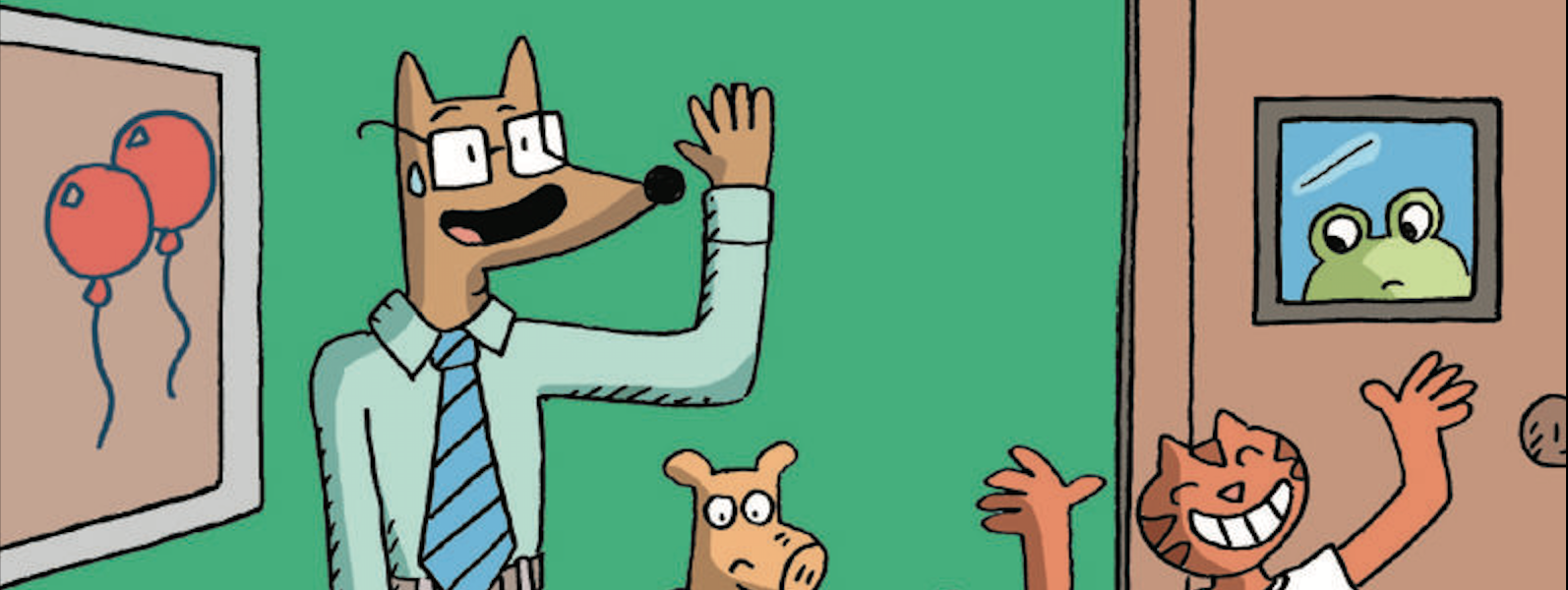With fall rapidly approaches and the steady bombardment of ads for notebooks, calculators, backpacks, there can only be on the culprit: Back to School season is officially in session. When I was a kid, the first day of school always brought up a mix of feelings. On the one hand, I was nervous about the day and all the particulars, but I was also excited to get back to a routine after the malaise of the summer vacation. These conflicting emotions always led to butterflies in the stomach before my parents dropped me off. But once I had made it to the classroom, saw my friends or began to meet new ones, and slung my backpack on my desk chair, I was ready and in game mode. Still, there was always the x-factor: the teacher. Would this steward of the next nine months of my life be up to the task to have the empathy, wisdom, and heart to assist me in my development as a human being… or would there be trouble ahead?
Tackling the first day of school as a kid is already a monumental task, but for teachers, the stress is just as high. Prepping lesson plans, learning students’ names, and ensuring that the classroom is in tip-top shape for supreme learning potential are essential components to ensure that any first-day jitters are kept to a minimum. And in Mr. Wolf’s Class (Graphix), writer and artist Aron Nels Steinke’s latest graphic novel, readers experience the trials and tribulations of a tumultuous start to the new school year with a group of rollicking and (sometimes) unruly fourth graders. For you see, not only is it the first day at school for the students, but it’s the titular Mr. Wolf’s day as well. Can he handle the pressure? Can he survive the day? Not too long ago, I chatted with Aron, himself a public school teacher, to get the inside scoop of Mr. Wolf’s Class, the balance of creating comics and teaching full-time, what Mr. Wolf might do on his off time from teaching, making sure young readers can follow a diverse cast of characers, and what the second day of school might bring.
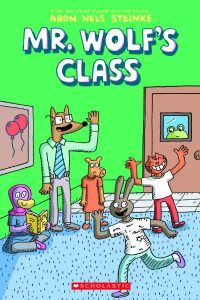
ARON NELS STEINKE: I’m not yet but I will be. I’ve still got a few days before I head back. I’m taking advantage of every spare minute of summer to work on the Mr. Wolf’s Class series. When I’m doing comics I like to go all in. When I’m teaching I do the same. I don’t like being distracted by either career so I can focus and do my best with each. In this regard, my summers and weekends are devoted to comics and my family of course. That said, thoughts on teaching are always finding their way in: How will I set up my room differently this year, what projects and field trips will we do, how will I structure our routines? A teacher’s brain rarely shuts off.
FROST: What emotions help guide you as you write and draw Mr. Wolf and his students?

STEINKE: I want the book to be fun, first and foremost. Getting a laugh out of a reader is really my favorite thing. I also don’t want any bullies in my book. That’s not to say that there’s no conflict or bully behavior. I just do not want a character whose sole purpose in the book is to serve as a one-dimensional antagonist. I think that can be damaging and sends a message to kids that bullies are an expected experience that you have to tolerate. The kids in Mr. Wolf’s Class are working on developing respectful relationships with each other, even if there is some conflict and hurt feelings in the process.
It’s strange because I didn’t really enjoy school as a kid. I was anxious and shy and had a hard time seeing the big picture. I did fine academically and I had some good friends but I would have much rather been home drawing, riding my bike, or exploring the woods. So when I became a teacher I was totally surprised when I found that most kids actually love school. The character Margot, who is also a rabbit, is the embodiment of the kid who never wants to miss a day away from her school community; she has a good home life but she thrives in the school environment. Of course, there are those kids for whom school is a refuge. Many kids do not have stability and support at home. I’m happy to report that year after year, the majority of my students seem to enjoy being in my class. Maybe it’s a testament to what I’m doing in the classroom.
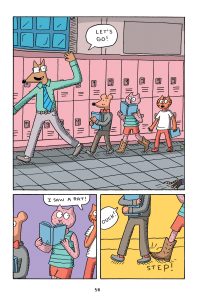
FROST: Besides taking place over the first day for students, the book also follows Mr. Wolf’s first day as a teacher. My impression is that this might be a second career for Mr. Wolf and he’s doing his best to make sure that everything goes smoothly for his students…and himself. Can you tell me a little bit about Mr. Wolf himself and where his character comes from?
STEINKE: Do you mean that he has two careers going at once? Mr. Wolf is certainly a stand-in for me and I do have two careers but I don’t know what his second career would be. That’s fun to think about. I’d probably make him a painter in honor of my brother. An abstract expressionist, maybe. That sounds good–thanks for the inspiration!
But if you mean that Mr. Wolf has switched from one career to another then that too comes from Mr. Wolf being my double. I started out in animation in my twenties and then when that didn’t work like I wanted it to, I started pursuing children’s publishing and comics. During that time I was working in food service to pay the rent. After several years of floundering around, I decided to go back to school and finish undergrad and then get my Master of Arts in Teaching degree. I was 30 when I got my first job as an elementary school teacher. Mr. Wolf’s Class takes place during Mr. Wolf’s first day of teaching at Hazelwood Elementary. He’s certainly not the young, fresh-out-of-college twenty-something teacher. He’s more like 32 or 33 years old and he’s really made this career a deliberate choice after moving on from something else.
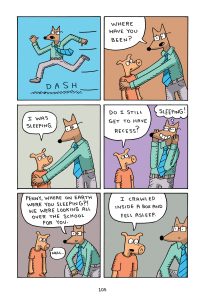
FROST: Part of the fun of this first Mr. Wolf book is that it explores a school day through the eyes of multiple characters. It’s a bit like Rashamon. Can you describe how you came to use this storytelling method? What are the most pressing challenges for using it in a children’s literature context, but also just to keep everything straight for yourself?
STEINKE: When I was planning Mr. Wolf I was thinking about episodic television as well as the Robert Altman film, Gosford Park. In a good television series, you get multiple perspectives and complex characters that grow over the course of the series run. Gosford Park does a herculean task of developing more than two dozen characters in just over two hours and it’s so much fun to watch and re-watch how their narratives are woven together. I had never done a series or ensemble before and I really wanted to try that kind of thing out. If I get my way, there will be many more Mr. Wolf’s Class books, and I’d like to develop all of Mr. Wolf’s students, even those that just appear to be supporting or even background characters.
I tried hard with this first book in the series to introduce as many personalities as possible without making the book too chaotic. I think one challenge is convincing myself that this model works. But I know it works because it works on television and it works in literature. It’s not a problem in Mr. Wolf’s Class because I’ve designed each character to look visually distinct from one another. Kids will typically read the book in about an hour. Then they’ll read it again, and they’ll read it again, and again, discovering new details and connections with each reading.
Another challenge is sticking with the ensemble model because I do have characters that I’m really fond of and it’s easier for me to write for them. But I know the book series will be richer if I force myself to develop those other characters and think about what makes them unique.
I love the Rashamon concept—how perception distorts our understanding of the truth through multiple characters’ memories around a shared experience. It’s something I often think about trying to do. I don’t think I quite achieved this with Mr. Wolf’s Class but I appreciate the comparison.
FROST: Can you tell me a little bit about the eponymous Mr. Wolf? How much of his character is based on personal experience and how much is based on the general disposition of teachers or colleagues you’ve interacted with during the course of your career?
STEINKE: Mr. Wolf is a fictionalized version of myself. He’s both me and not me. I started putting him in my autobiographical minicomic, Big Plans, back in 2007 and I’d use him as my stand-in whenever I was feeling hyperbolically cranky. Back then I had a frustration inside that stemmed from my inability to make a living wage. I had so much anxiety over my wanting to be an artist and to maintain a relationship with my then girlfriend (now wife). Without a way to significantly contribute to our finances, I felt so worthless. Once I got my first teaching job, I felt that anger and frustration melt away.
While I was teaching I wanted to keep making comics but I didn’t have the time to really write and explore ideas so I decided to just write about what I knew—being in the classroom. That’s when Mr. Wolf as a character really started to mature and he began to represent my sweeter and more nurturing side.
Those early Mr. Wolf webcomics and minicomics were written with the idea that these were universal experiences that would appeal to other teachers, too. It turned out they were useful in my classroom so I began thinking of my students as my readers.
I would generally make a comic about something that happened during the day then I’d delete the words and print copies for my students. My students then would complete the story with their own word balloons, thought bubbles, and narrative captions—and they loved it! That’s when I had the idea to shift away from the minicomics and start writing Mr. Wolf’s Class as a graphic novel series for kids.
FROST: One of the aspects of the book I appreciated the most was that you explore the backgrounds of all the students. Some are diligent, some are silly, some have challenging home lives that affect their school work. How important is it—as a pedagogical tool, but also narratively—to display to the reader that each student has a unique perspective?
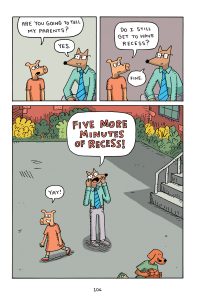
STEINKE: As a teacher, I’ve gotten to know a diverse range of young people. I did most of the concept work for Mr. Wolf’s Class while I was working at an incredibly diverse school. Our student population represented over 26 different language groups and, in a way, it seemed like a pluralistic utopia. It was the byproduct of a rapidly gentrifying city, however, it was still an incredibly welcoming place. We had refugees, asylum seekers, immigrants from North Africa, The Middle East, Southeast Asia, Central and South America. I want readers to find characters to identify with that maybe they didn’t think they would at first. I want to foster empathy without being preachy. I just want to reflect and represent the reality that I experience in the classroom but I also just want to encourage kids to read and have fun while doing it.
FROST: As a follow-up, were the students you portrayed in the book based on real students of yours or were they all just part of your imagination? Maybe an amalgamation?
STEINKE: Some of the characters were initially inspired by real people, and many were amalgams. Some characters started out as different versions of myself, even. But over time they have all gone on to have lives of their own. They live free now. When I sit down to write, the stories start to write themselves. I pull the thread and it unwinds. Sometimes I have to burn the thread and pull at another to get it just right.
FROST: Mr. Wolf’s Class is the first in a series. When does volume 2 release? And what’s next after that?
STEINKE: The next Mr. Wolf’s Class installment, Mystery Club, comes out on February 26th! Right now we’re just putting on the final touches to have it ready for printing. And I’m happy to report that I finished inking all 176 pages for Book #3, Lucky Stars, just this week. Now I can start coloring. My hope is that the Mr. Wolf’s Class does well enough that I can keep making more volumes. I would love to go back in time and share this book with myself when I was a kid–I think if I had the graphic novels that are available to kids now back when I was in school, I would have been much happier. We are truly living in a new Golden Age of Comics.
Mr. Wolf’s Class is available now.
I dedicate this interview to my own fourth-grade teacher, Mrs. Joan Strong. And to all my friends who are teachers, good luck to you for another year of teaching!


